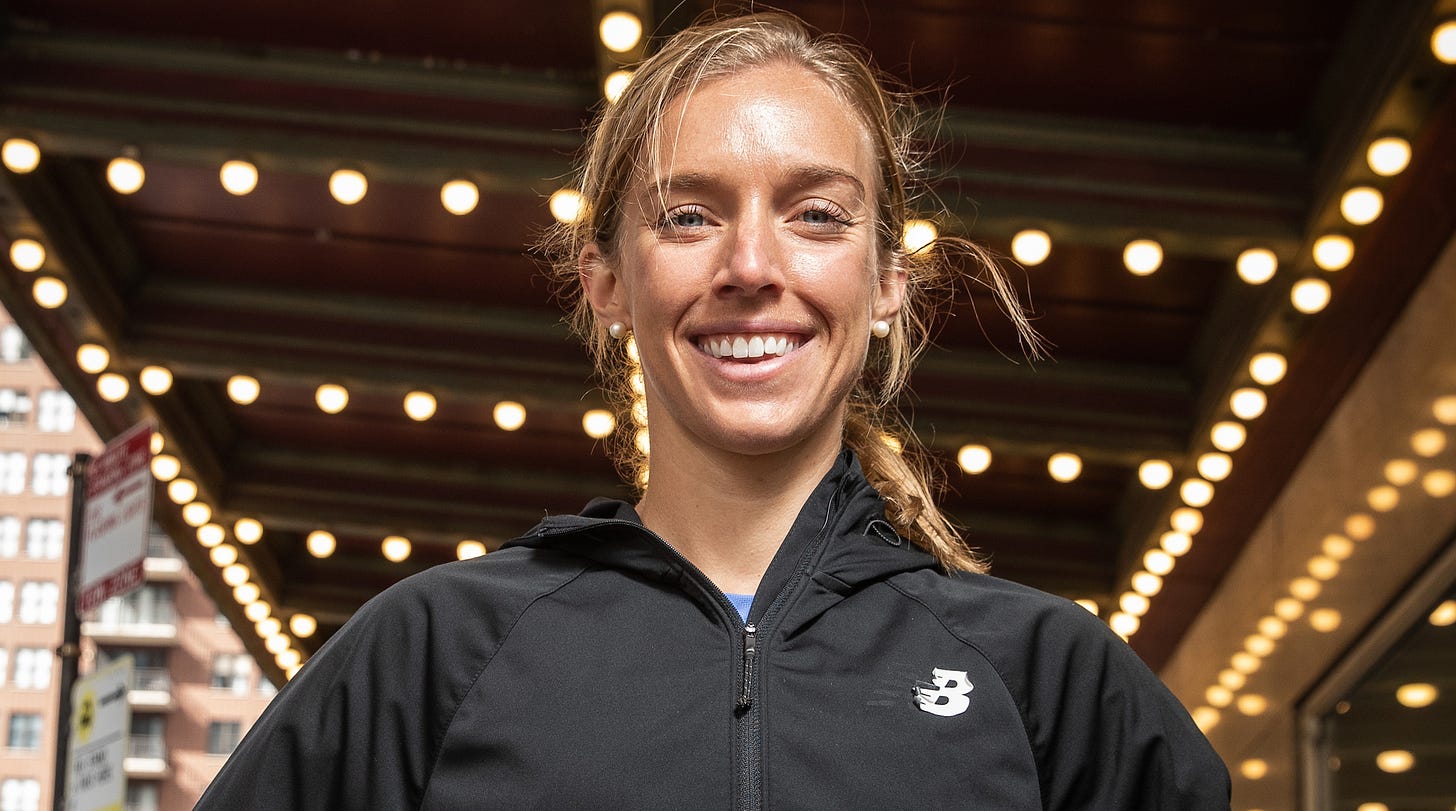Interview: Emily Sisson After Breaking The American Record At The Chicago Marathon In 2:18:29
How Emily Sisson took 43 seconds off the previous U.S. women's marathon record
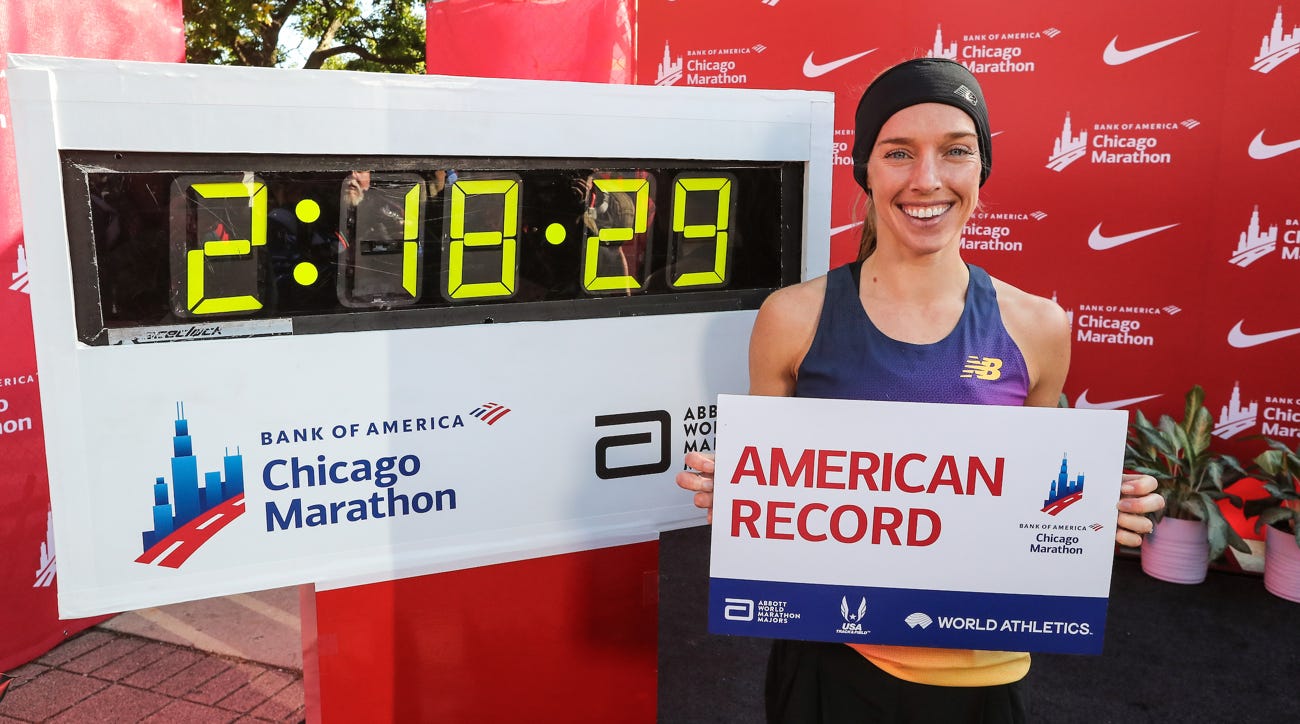
A special edition of the newsletter coming your way to bring you a fresh interview with the new U.S. women’s marathon record holder Emily Sisson. She just ran 2:18:29 to take 43 seconds off the previous record of 2:19:12 set by Keira D’Amato at the Houston Marathon in January. In case you missed it, the race was won by Ruth Chepngetich in 2:14:18 – which is the second-fastest time in history. Sisson now owns two of the biggest American records. She set the half marathon record in 67:11 back in May.
In this podcast episode, we go inside the making of this American record, how she trusted her coach and pacers to make it happen, the appetite to go faster and what’s being said in this group chat with U.S. marathoning greats Keira D’Amato, Deena Kastor and Joan Benoit Samuelson.
You can now listen to our conversation on The CITIUS MAG Podcast. Catch the latest episode of the podcast on Apple Podcasts. We are also on Stitcher, Google Play and Spotify.
I’ve transcribed a few parts of the interview below, which have been edited lightly for clarity.
CITIUS MAG: The new U.S. women’s marathon record holder. How’s that sound? Have you gotten used to it yet?
Emily Sisson: It is sinking in now. It does feel amazing. It’s been such a big goal for so long. I remember back in college, Ray (Treacy) said to me once, “You’re going to set the American record in the marathon someday.’ I was like, ‘Okay…’ But he said it as a fact like, ‘You’re going to do it.’ Just because someone has the potential doesn’t mean it necessarily will happen. There are so many factors and variables. But he was just like, ‘No. You will set it someday.’ It feels like part of a long journey.
CITIUS MAG: Ray said that in college. It took a while for you to move to the marathon and debut. Did what he said ever pop back into your head while you were still on the track? There’s a level of patience with this finally being fulfilled?
Emily Sisson: I am pretty good at being grounded in the present and whatever my next race is. That’s what I’m focused on. It’s been this thing in the future. I’ve always been aware that Ray was like, ‘You will be a marathoner someday.’ I like going at my own pace. I always move at my own pace. I remember when he said that I knew I’d take my time getting to the marathon because there’s so much I want to do on the track first. There’s more stuff I want to do at shorter distances first. I wanted to focus on getting the most out of myself on the track and then work up to a half marathon and work my way up there. In the present moment, I was always looking at what I was just about to do.
CITIUS MAG: I’m thankful and honored that you responded to my text to make this happen. I saw that your husband is having trouble getting a hold of you since you’re in this group chat with Keira D’Amato, Deena Kastor and Joan Benoit Samuelson. Who started that and what’s being shared?
Emily Sisson: I think Deena started it. She shared the selfie she took at the finish line to all of us. I was responding to a few texts but I was also responding to the group chat. That tweet kinda took off a bit. It’s cool talking to them. They’ve just been so nice. They’re incredible women that have left just amazing legacies in the sport. I’m just really honored that they’re texting me.


CITIUS MAG: When you cross the finish line, there’s a lot of emotion to take in. You find out the time from your husband. Keira is right there and shares a moment with you. Then you’re surrounded by all these U.S. marathoning greats. At any point did you black out? That would be emotional overload for most people.
Emily Sisson: I didn’t know what my time was or what my place was when I crossed the finish line. I thought I was just really focused on getting to the finish line but I heard maybe the clock wasn’t working. I don’t recall seeing it but maybe I was just focused on getting there as fast as I could. I ran into my husband and I was so tired. He says I ran into his arms but I think I was just tired of standing and he was holding me up. I asked, ‘What did I run? What place was that?’ He was like, ‘You ran 2:18:29!” And I said, ‘What?! Really?!’ I didn’t think I was on that pace. I saw Ray Treacy and (my agent) Ray Flynn right away alongside Keira. It was a lot at once but it was all amazing. Overwhelmed in the best way.
CITIUS MAG: What did Ray Treacy say? ‘I told ya so?’
Emily Sisson: It’s funny because I think I said this to Carrie Tollefson the other day but when I was getting ready to go to the start line, the last thing Ray Treacy said to me was, ‘I’ll see you in two hours and 18 minutes.’ I was like, ‘OK. Sure. Whatever.’ (Laughs) I just went to the start line and think he’s being optimistic. Sure enough, he was right again.
CITIUS MAG: You kept your cards fairly close to your chest. It felt like a big game of will she or won’t she? You said you’d go for sub-2:20 and see what happens. When was the plan set to attack the record?
Emily Sisson: I was being genuine! I didn’t think it was an American record attempt. It was but it wasn’t. It’s kind of hard to explain. I feel like I’m really good at gauging my fitness for everything half marathon and down just based on past experiences and past workouts before big races. I know what the indicator workouts are. And the marathon, I’m still so new to this event. It’s still so new to me. London Marathon went really well back in 2019 but so many things have changed since then. Even in that race, I know some things didn’t go according to plan and I felt like my fitness was better on that day. I was trying to compare workouts and where I was at then to now but I didn’t have a lot of data to go off of. I was pretty confident I was in sub-2:20 shape. I just didn’t know by how much. Ray Treacy was very confident. He was like, ‘You can get this record. I’d be shocked if you don’t run under 2:20.’ I was a bit more conservative. I feel like I get more confidence out of the experience and I just lacked that in the marathon. I thought under 2:20 would be amazing. I haven’t finished a marathon since April 2019 so I would love to get under that 2:20 barrier. If I’m close to the record, I will go for it. He was just right. He knew where my fitness was. I think with each marathon I’ll get better and better at knowing where I’m at and what I’m capable of. I felt like I was just taking a leap of faith. Usually, I like looking at workouts and I kind of know where I’m at going into any race but this time I didn’t know. We’re just going to find out.
CITIUS MAG: Did anything stand out in reviewing your training?
Emily Sisson: What stood out to me was that I was able to get a really good build-up with no hiccups at all – no injuries, no illness, nothing. That gave me confidence. I knew I was fit but I didn’t know what that meant. I was looking at times from workouts before London and workouts before this race. They were faster but not significantly faster. I knew I was training in hot, humid New England and for London, it was winter in Arizona, which is the perfect time to train there. I know I’m a different athlete than I was then so I have to go with what Ray says. That’s why I didn’t look at my watch. I think he knew. He wanted me to focus on how I feel and now what my pace is. The only split I saw during the whole race was the half marathon split. I really didn’t know what my mile splits were. I wasn’t aware of how fast we were running and that’s probably the best advice he gave: Don’t look at your watch.
CITIUS MAG: When you say you’re a different athlete now. What’s the biggest difference?
Emily Sisson: I’m just stronger. I feel stronger. Every long run I did this build-up, I felt pretty good after. Before London, every long run really beat me up. The next day, I’d be hobbling around a bit just really tight, sore and stiff. I absorbed the mileage better. I feel like I have more experience now. I knew I put in work and didn’t feel like I was red-lining it the whole build up. Whereas in the last two build-ups, I felt like I couldn’t have done a single mile more since I was so close to that edge the whole time. This time, I actually felt like my body handled the work well. If I wanted to, I could’ve done a bit more but maybe that’s not necessarily a good thing. More isn’t always better.
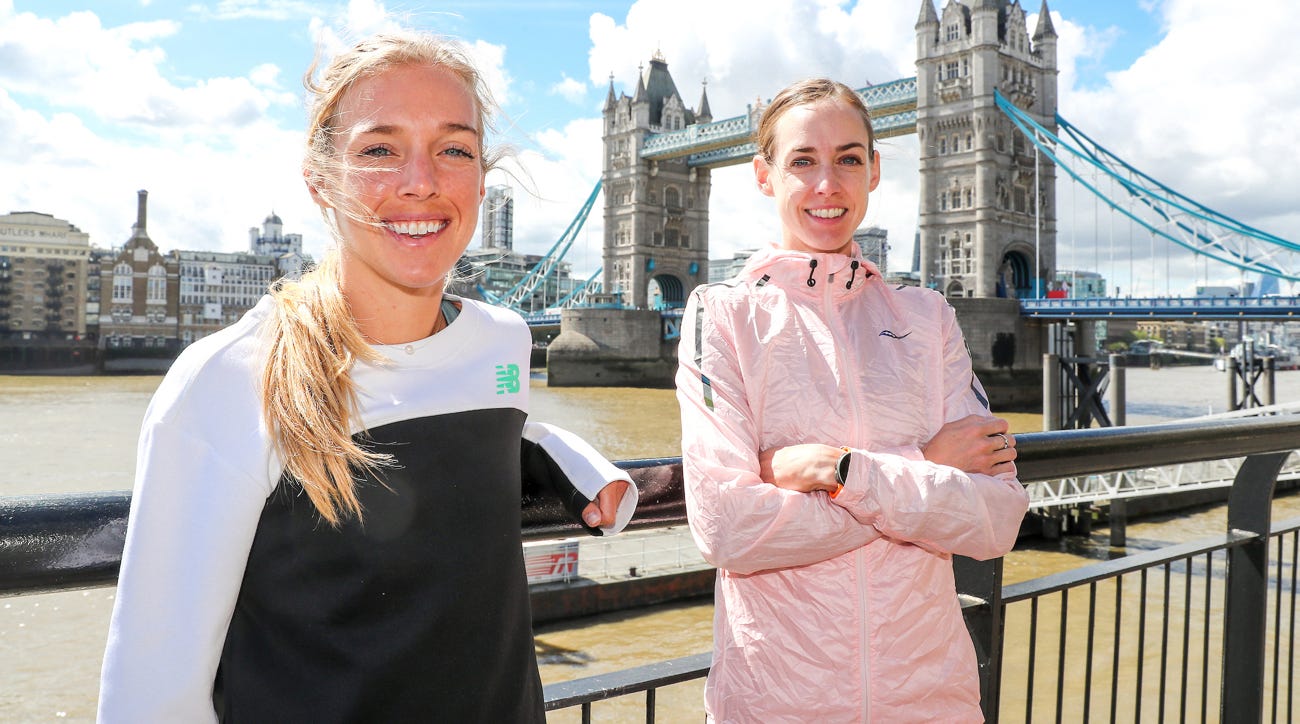
CITIUS MAG: You’re the new shining example of coach Treacy’s success with marathoners but he had Molly Huddle and Kim Smith before you. In these last three years, what is at the heart of his training philosophy that might be a bit different from all the years that you worked with him on the track?
Emily Sisson: Our training doesn’t change that much between 10K, half marathon and marathon training. I just do more mileage. Everything is just a little bit longer. My workouts don’t slow down a lot. I do less fast stuff. The fastest stuff I did this build-up was 1200m repeats and 800m repeats. It’s really not all that different. We just do between 110 miles and 115 miles a week. We slow things down a little bit but not much. I remember after one workout – we were doing mile repeats and I think I was averaging about 4:55 pace for them. He noted that it would only take me about a month to pivot from marathon training back to 10K training because we just don’t lose touch with speed. We add mileage but we don’t lose our speed.
CITIUS MAG: Did you prefer being in New England for this build-up compared to Flagstaff for the last one? I know some of the reasons for the change were COVID related at the beginning, right?
Emily Sisson: That’s what I think happened. I was a little in denial at first about how much COVID affected me. I just don’t want the next time I get it to be sidelined or just to feel that tired for so long. It took three to four months until I was feeling myself again. My heart rate dropped and some other symptoms I had went away. I could be wrong but because we had just moved to altitude, it was something I hadn’t fully adapted to. Living up there is just more stress on the body. When I got sick, especially with COVID, my body was having a hard time recovering. Every time we dropped down to sea level, the symptoms would ease off. After a month of being in Rhode Island, everything went away at the same time.
CITIUS MAG: That kind of answers my next question as to whether training for the half marathon record attempt or this marathon was tougher. I’m guessing the half because of the recovery from COVID.
Emily Sisson: The month leading up to the half marathon was tough. We had to drop down to sea level to do that. I think I got COVID five weeks before we ran that. The three weeks after COVID I couldn’t work out. I kept trying but I just couldn’t. We dropped down to sea level for the last two weeks and I was able to get four workouts in. I knew I wasn’t in the same shape I was in pre-COVID but I was pretty confident because I have a good idea of where my fitness is at. I thought I was in 66:30 shape. I thought that if I got COVID and I’m not quite as fit, I think can still sneak under the record if it all goes well – it just might be a little harder. It was really hard. We had two really good pacers that day. Brian Harvey was encouraging me that last mile or two because I was struggling. I don’t think I’ve ever struggled so much in a race. I’d say that was harder just because of where we were coming from before it.
CITIUS MAG: We had this stat that blew up on Twitter. Of the seven fastest U.S. women’s half marathons of 2022, you have the fastest with the American record at the top. The second half of your race in Chicago 69:03 is No. 5. The first half of your race in Chicago was 69:26 and is No. 7. It seems like you have more to give to take that time down.
Emily Sisson: I didn’t see that. That’s cool. I’d like to. That would be a fun goal to go after. I’d like to lower the half marathon record. I wouldn’t be surprised if someone lowers it first. I know there are so many people capable of running low-67 minutes in the half. I still want to do it myself first. That would be a fun one next. I don’t know when my next marathon will be. I don’t know if I’ll go for a fast time again or if I’ll try to do something else. We’ll probably end up working backward from the Olympic Trials and figure things out from there.
CITIUS MAG: Have you sworn off the track?
Emily Sisson: I don’t know if I’ll try to make a team again. I do think it’s important for me to do faster stuff in training. Faster to me means like 1200ms in 72 or 73 seconds. I don’t know if I’ll do a full season. The track season is like clockwork to me. At the end of each track season, my body is just beaten up and I just need a break. If I want to focus on the marathon, I just don’t want to spend that time recovering after a track season or dealing with an injury or having it affect my spring build. I might hop in for like a race or two. Maybe I do USAs or a 10K in the middle of a marathon build-up. I don’t think I’ll do a full season anymore. But who knows I can always change my mind! (Laughs)
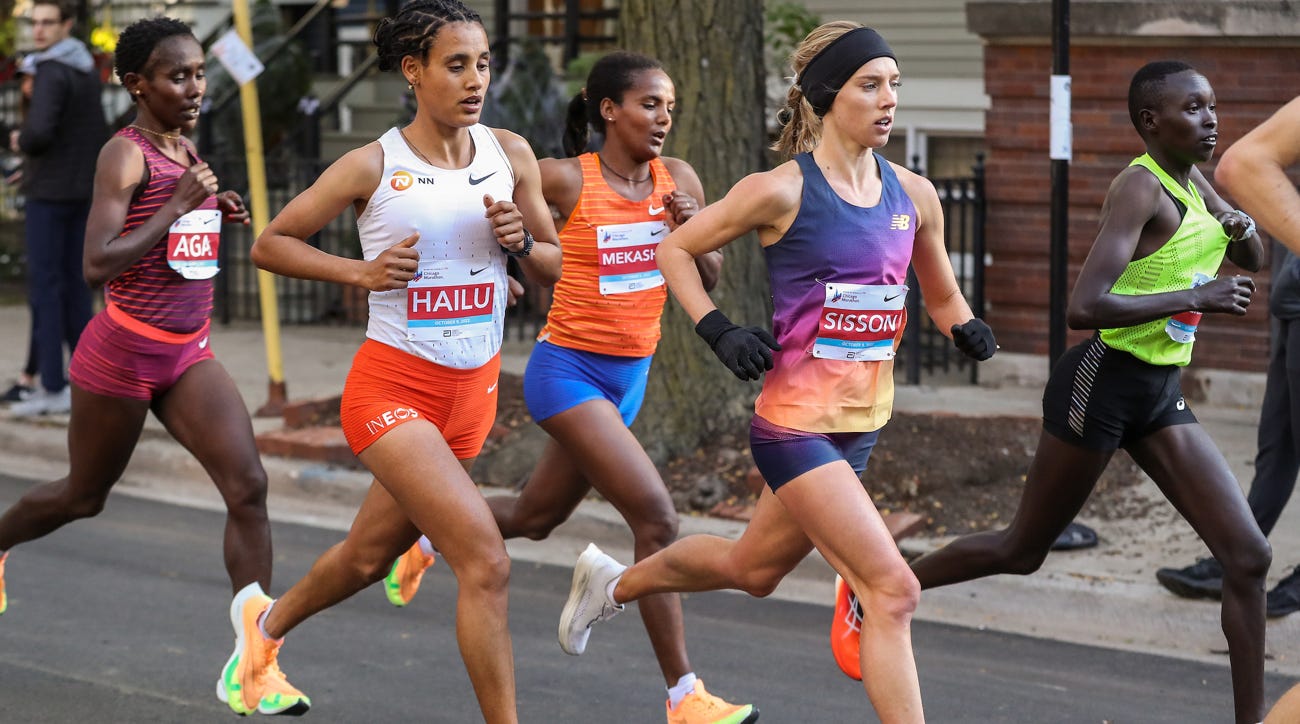
CITIUS MAG: Alright, let’s unpack the race. We didn’t get to see you on TV much. What was your reaction to seeing Ruth Chepngetich take off running? She was running alongside Pat Tiernan for a while.
Emily Sisson: She took off along with a few other women. I watched the race last year and I remembered that she took off and went really fast. She did a big positive split last year too but she still holds it together.
CITIUS MAG: She didn’t die as hard this time around.
Emily Sisson: Yeah, it wasn’t humid this year. Even when she goes out really fast, it’s still hard to beat her. She’s just an incredible athlete. So I knew she went out fast I thought a lot of women would come back who went out with her. She’d probably have to have a pretty bad day for her to come back. I was kind of just focused on my race and running with my pacers. I’m sure we’ll catch up to some people and be able to pick people off. Sure enough, that’s what we did. I didn’t know when we got to the group that came back to us how many people were still ahead.
CITIUS MAG: She was ahead by a bit had she dropped out there was a chance you cross the finish line confused as to whether or not you won because of the lead she had. So you must’ve been running with no clue what place you were in.
Emily Sisson: I knew I wasn’t winning because if you’re winning they have the lead vehicle so I knew that. I didn’t know I was in second. I did think I had a shot at the podium and top three. Am I third right now? Am I fourth? My pacer Jonny Mellor kept asking people and a lot of the men who came back to us. He would ask how many women were ahead and no one was responding to him. He kept trying. That would’ve been really good feedback. He kept trying to find out where we were because I don’t think he knew either.
CITIUS MAG: Your splits were 69:26 for the first half and 69:03 for the second half. You never looked at your watch. Was it just trusting these pacers that have been instructed by Ray and shutting your brain off and going? What’s going through your head to run it so perfectly?
Emily Sisson: A lot of it was my pacers doing an incredible job with their job. I was instructed not to look at my watch. I did look at it but I was looking at it more for distance and not pace – it was to see how close we were to the next bottle table. My eyesight is not the best and oftentimes while racing I can miss the sign that says ‘Bottles. 50m ahead.’ I was looking to see every 5K on how close we were getting to the next one. About 10 miles into the race, I accidentally hit something on my watch and it turned off completely so I really didn’t know what pace we were running apart from halfway I saw that split. I vaguely knew the pace we were going out at from the meeting we had before. I was a little late but it was me, Johnny, Brian (Harvey) and Ray. He said told me what my splits should be for 5 miles, 10 miles and 20 miles. I wrote them down but I didn’t know exactly what they meant. I thought they’d be sub-2:20 pace or 2:19 pace but I didn’t know exactly what any of those numbers meant. I kind of threw numbers out the window and went off my pacers the entire time.
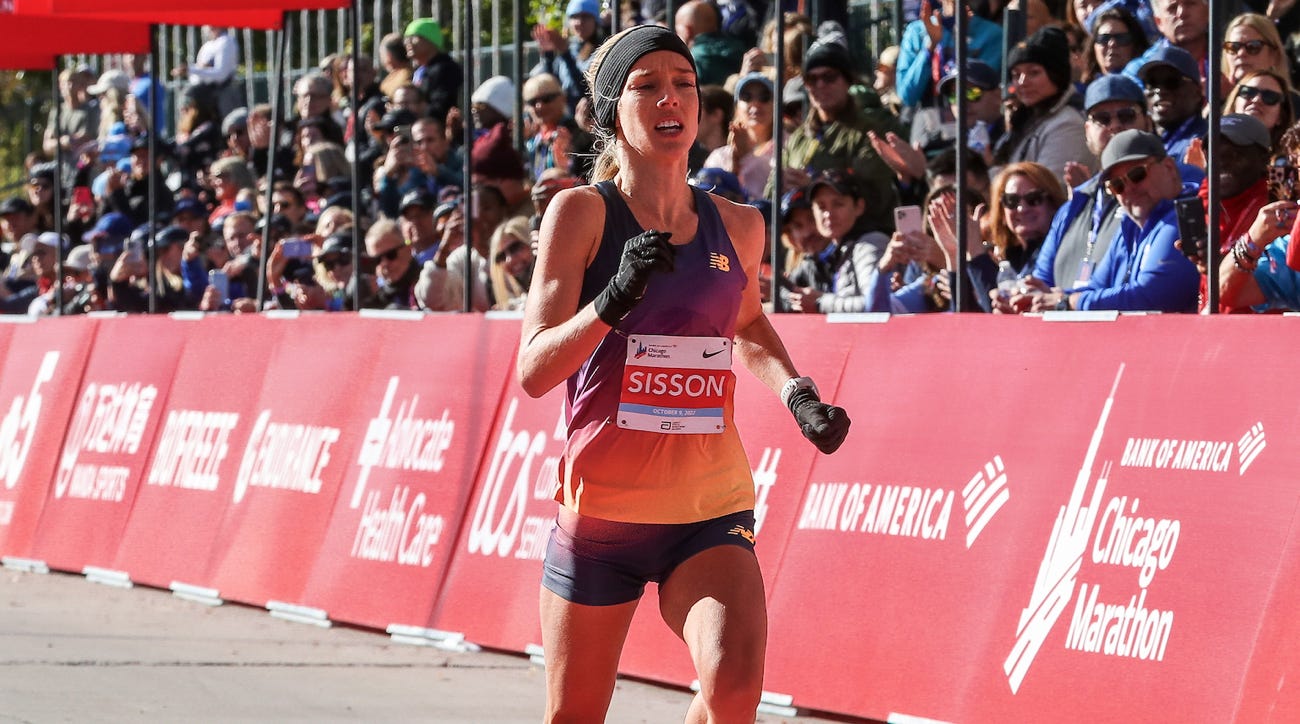
CITIUS MAG: Was there more left in the tank? Your fastest 5K was 16:19 from 35K to 40K and then your final 10K was 32:40. That track speed was still there at the end.
Emily Sisson: It did. I have found within the past year that even when I am tired I can still kick. But I do think the marathon is a little different. I was working. I just didn’t know what my time was or how close I was to the record. I do think maybe I can go a little bit faster. Maybe someday I’ll try to run a little faster.
CITIUS MAG: You’ve got some people wondering about the shoes. What was your choice of New Balances for the day?
Emily Sisson: I wore the Fuelcell Supercomp Pacer with the Fuelcell foam. I wore them for the USATF 20K Championships so this was only my second race in them.
CITIUS MAG: Someone else asked: What was the fueling strategy for the race?
Emily Sisson: I switched off between mix and gels throughout the whole race. This was one of the things I was probably the most nervous about because it can be hit or miss with marathons. I heard so many stories about getting cramps or not fueling enough or fueling too much. Before the race, I tried to make sure I had water. I had some coffee and some UCan energy. Afterward, I made sure I had some protein right away.
CITIUS MAG: What was the celebration meal?
Emily Sisson: I had a burger and a glass of wine with my family. Normally, I wouldn’t have those two things together but I just wanted it.
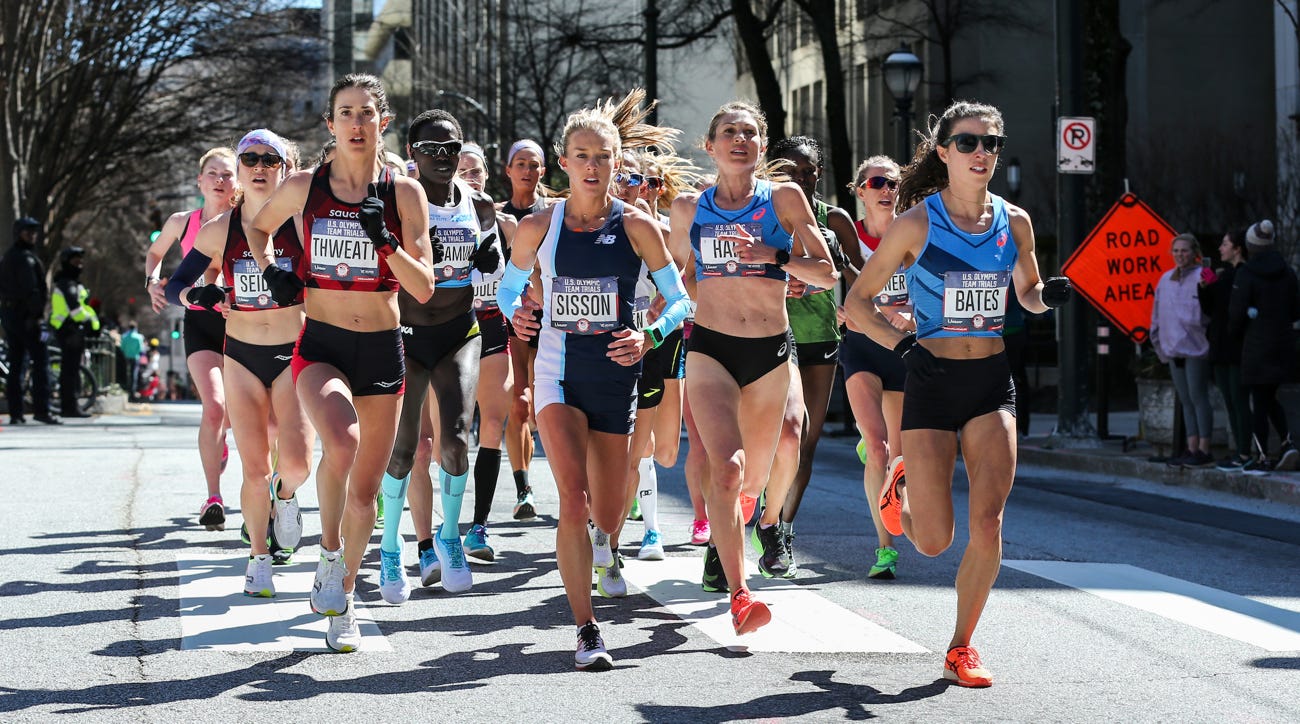
CITIUS MAG: We know how high the hopes were for the Marathon Trials last time. They’re actually not that far away yet because we don’t know where they’ll be yet since USATF hasn’t announced it yet. What is it that you think you need to do between now and then to put yourself in a position to possibly make the team?
Emily Sisson: Well, it would help to know what the course looks like this time. I’ve heard they’ve narrowed it down to two places and I hope we know relatively soon. I’ll have to talk to Ray because it will depend on whether it’s at and what the course looks like. Atlanta didn’t go my way that day but I don’t think I only need to run flat marathons. I could be wrong but if it is somewhat hilly, I would like to change my training to prepare better for that. Something Ray told me once is that he thinks I can handle courses with hills. I just need stretches of flat road to recover from that. A lot of my training will depend on what the course looks like. Maybe we’ll play around with altitude to see how that affects marathon training for a spring marathon this upcoming year.
CITIUS MAG: The track trials performance last year was so good. You’ve got the American record in the marathon and the half marathon. Where does Chicago rank among your favorite career achievements?
Emily Sisson: I would say it ranks up there with the U.S. Olympic Trials on the track. That was a very special moment so I think those are my top two.
CITIUS MAG: Kyle tweeted: “Thinking about how @Em_Sisson ran 15:48 to set the HS 5000m record 12 years ago and how brilliant of a career move it was transferring to Providence after her freshman year to be coached by Ray Treacy.” Do you find yourself reflecting on how well these 12 years have been?
Emily Sisson: I do remember when I transferred I had a conversation with Ray and he told me, ‘I think you can have success in the sport longterm but we’ll take a very long, slow approach. We won’t change your training significantly overnight. It’s going to be years and years of work. It has been over a decade working with him. I don’t reflect often but I am really glad that I have such a great support system and support team. It’s a small team but everyone in it is the best of the best. My attitude is there’s nothing I can do to guarantee I achieve my goals in the sport but if I surround myself with the best people – the best coach, the best chiropractors – then it gives me the best shot at my goals and at the end of the day that’s all I can really do, just give myself the best chance.
CITIUS MAG: Last thing. What excites you about the state of U.S. women’s distance running right now?
Emily Sisson: It is incredible being a part of it. I just feel like there are so many women right now that are raising the bar. It is like that saying: Iron sharpens iron. Just to be a part of it is a really cool experience. I feel like there’s even more we’re going to see unfold over the next how ever many years. It’s an honor to be part of it. It’s an exciting time.
Thanks for reading! If you enjoy the newsletter, don’t forget to tell a friend or two to subscribe. We love track and field and want to connect with as many people who share that love.
🙏 Chris Chavez (@ChrisChavez) & David Melly (@DavidMellyRuns)





